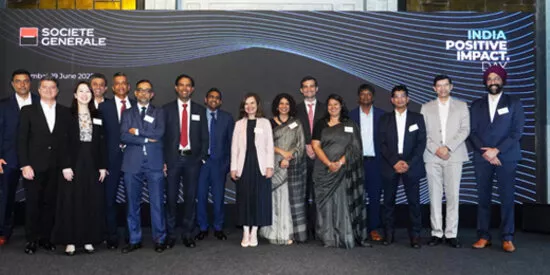
A path towards more sustainability and responsability in asset management
If the finance industry is to support the achievement of the 2030 targets set by the 17 United Nations (UN) Sustainable Development Goals, then asset management is one of the key. The capital sums controlled by the sector are vast. The cultural and commercial influence of big investors and leading fund managers is tremendous.
Fortunately, the omens are good. The asset management industry is increasingly committed to the goals of Sustainable and Positive Impact Finance.
"There are three key reasons why there is such as strong appetite," says Isabelle Millat, head of sustainable investment solutions within the markets activities of Societe Generale. "The first is the mounting evidence that there is a risk-return enhancement by adopting ESG (environmental, social, governance) criteria amongst other investment criteria."
"Second, the desire to have a positive environmental or social impact is driven by the end owners of the assets, the investors."
"And third, there is a regulatory incentive. In France, article 173 of the Energy Transition Law strengthens ESG reporting requirements for institutional investors, including asset owners and investment managers. So those who are not pushed by the first reason or the second, will be by this third, regulatory constraint."
This three-pronged motivation means the ESG-compliant assets are growing fast. The Global Sustainable Investment Review 2016, produced by the Global Sustainable Investment Alliance, calculated that there was $22.89 trillion of assets being professionally managed under responsible investment strategies at the time of publication, an increase of 25 percent on 2014. In terms of all professionally managed assets globally, responsible investing constitutes 26 percent of the total. The report states emphatically: "Clearly, sustainable investing constitutes a major force across global financial markets."
It must be noted there are shades of disagreement over the definition of sustainable investment. The review looks at seven categories:
- Negative/exclusionary screening,
- Positive/best-in-class screening,
- Norms-based screening,
- Integration of ESG factors,
- Sustainability themed investing,
- Impact/community investing, and
- Corporate engagement and shareholder action.
The first of these, exclusionary investing, is the largest strategy, with $15.02 trillion under management, followed by ESG integration with $10.37 trillion. But still there is no agreement, nor imminent harmonisation, of definitions or methodologies.
"Sustainable and Positive Impact Finance is still viewed through several mindsets" says Florent Deixonne, head of new products and risk governance and head of SRI at Societe Generale's asset management division LYXOR. "Some see it as a way to invest in larger environmental projects, combining financial return with impact. Others see it as a way to find opportunities overlooked by traditional investors and so outperform benchmarks. Others think they must accept lower returns, and their only criteria is to create social benefits."
He calls for a standardized vocabulary to ensure the industry is able to find common ground.
Some investors are so big they use their own bespoke criteria. For example, Norway's sovereign wealth fund, with $1 trillion under management is making the transition to sustainable investing. The Norwegian central bank, which manages the fund, recently advised the government to sell shares in the oil and gas sector. The move was hailed as an environmentally friendly move, although the official statement stressed the investment risks associated with hydrocarbons: "The return on oil and gas stocks has been significantly lower than in the broad equity market in periods of falling oil prices," the central bank explained in a statement. "Therefore, it is the bank's assessment that the government's wealth can be made less vulnerable to a permanent drop in oil prices if the GPFG (sovereign wealth fund) is not invested in oil and gas stocks."
The move in Norway is being mirrored in Japan. The national Government Pension Investment Fund, a $1.4 trillion fund, announced it is searching for global ESG stock index providers. In July, the fund made its first ESG billion in 2014 to $473.6 billion in 2016. It's a vast leap (although admittedly explained by changes to the allocation. According to the Japan Sustainable Investment Forum, the total sustainable market in Japan rose from $7 way data is reported).
Investors will also change behavior when the right products are available. To grow the market, banks must constantly innovate with products which meet both investors' customized financial needs and their latest ESG priorities: for example, in 2017, Societe Generale has launched a range of indices that combine equity risk premia and ESG, and structured solutions that support Positive Impact Finance.
ETFs are also good vehicles to jumpstart ISR investments. While liquid, with a small initial investment level and low management fees, they are transparent tools and this fits well with the principle of responsible investing. "We have pioneered ESG solutions development, with the launch of four ETFs that focus their investments towards the United Nations' Sustainable Development Goals namely in water, energy, also through the first green bond ETF, and a gender equality ETF," says François Millet, head of ETF & Index Product Development at Lyxor Asset Management. The last of these selects companies which promote equal compensation and work-life balance, gender balance in the leadership and workforce, and commit to transparency and accountability.
It is clear that the momentum behind sustainable asset management is strong. More than half of managed assets in Europe use responsible investment strategies, and a fifth in the United States. Progress is being made across the world.
As a sense of urgency around ESG issues grows (climate change transition, resource scarcity, access to healthcare and education ... ) the energy behind ESG investing will grow.
"Sustainable investing can be the new black!" says Florent Deixonne. "There is no reason why we can't see massive shifts."
Norway and Japan moving national funds to sustainable investing is symbolic of a larger trend. Asset managers are embracing ethical investing as a mainstream philosophy. New products, new regulations, and continuing pressure from investors will keep the numbers moving in the right direction. The UN's goal of diverting 5 to 7 trillion euros a year to fight climate change, and other causes, is now looking plausible.
Discover Societe Generale CIB 'positive impact finance' solutions




